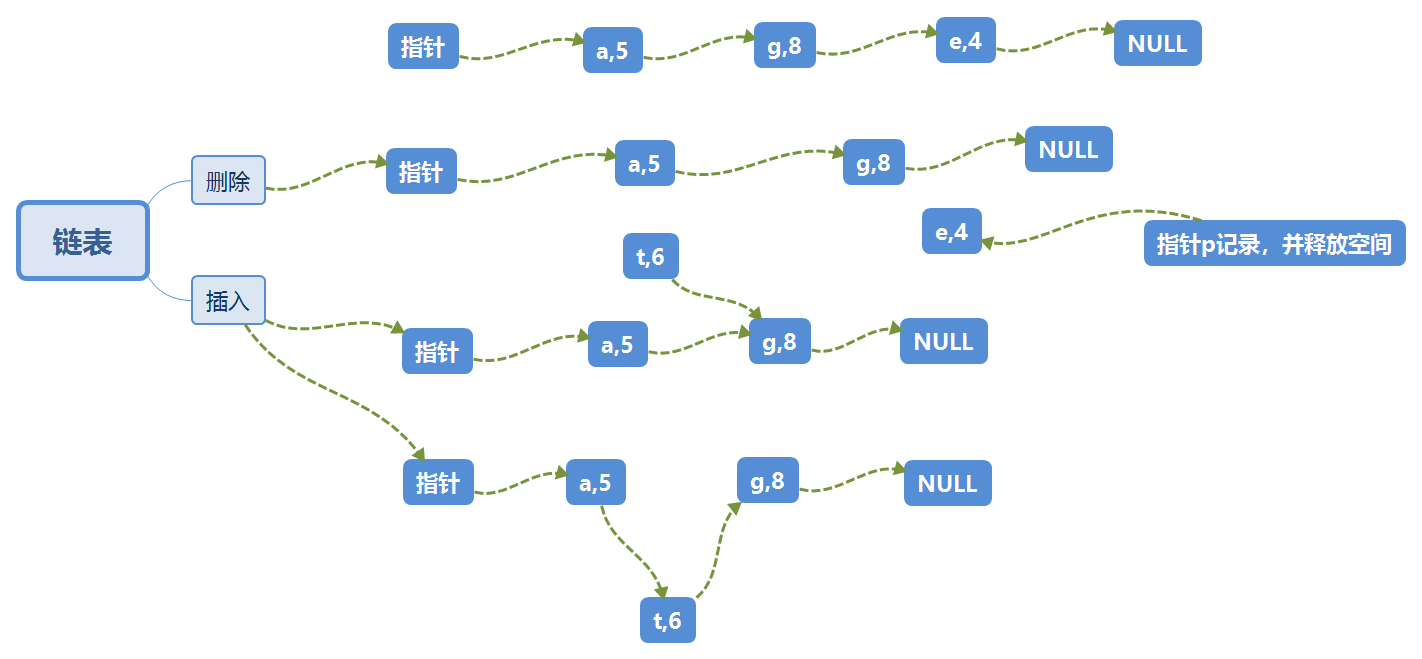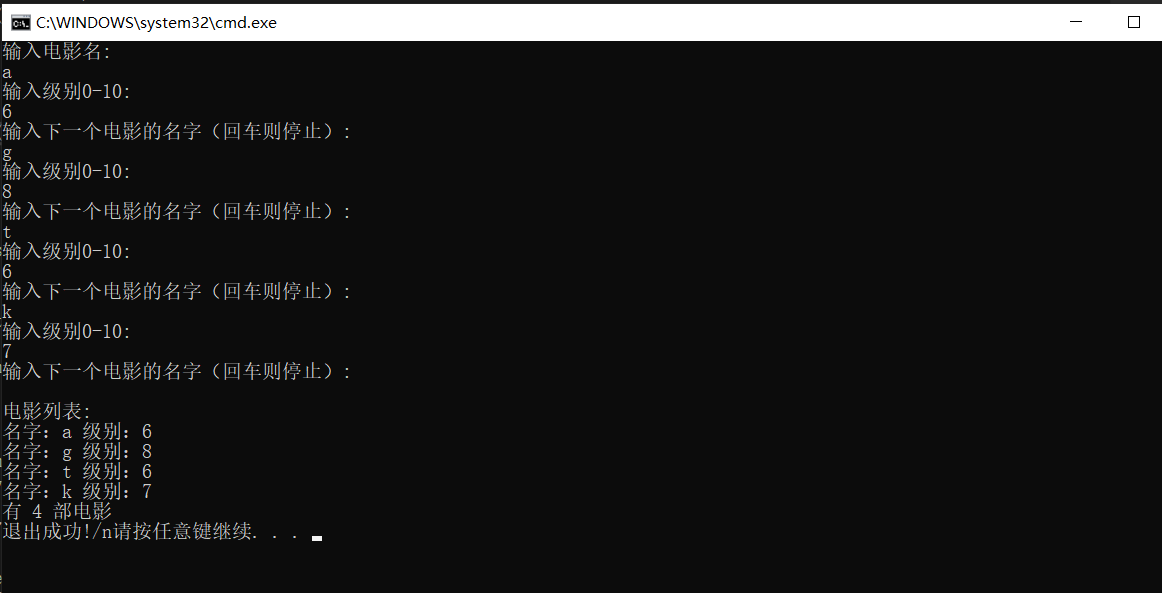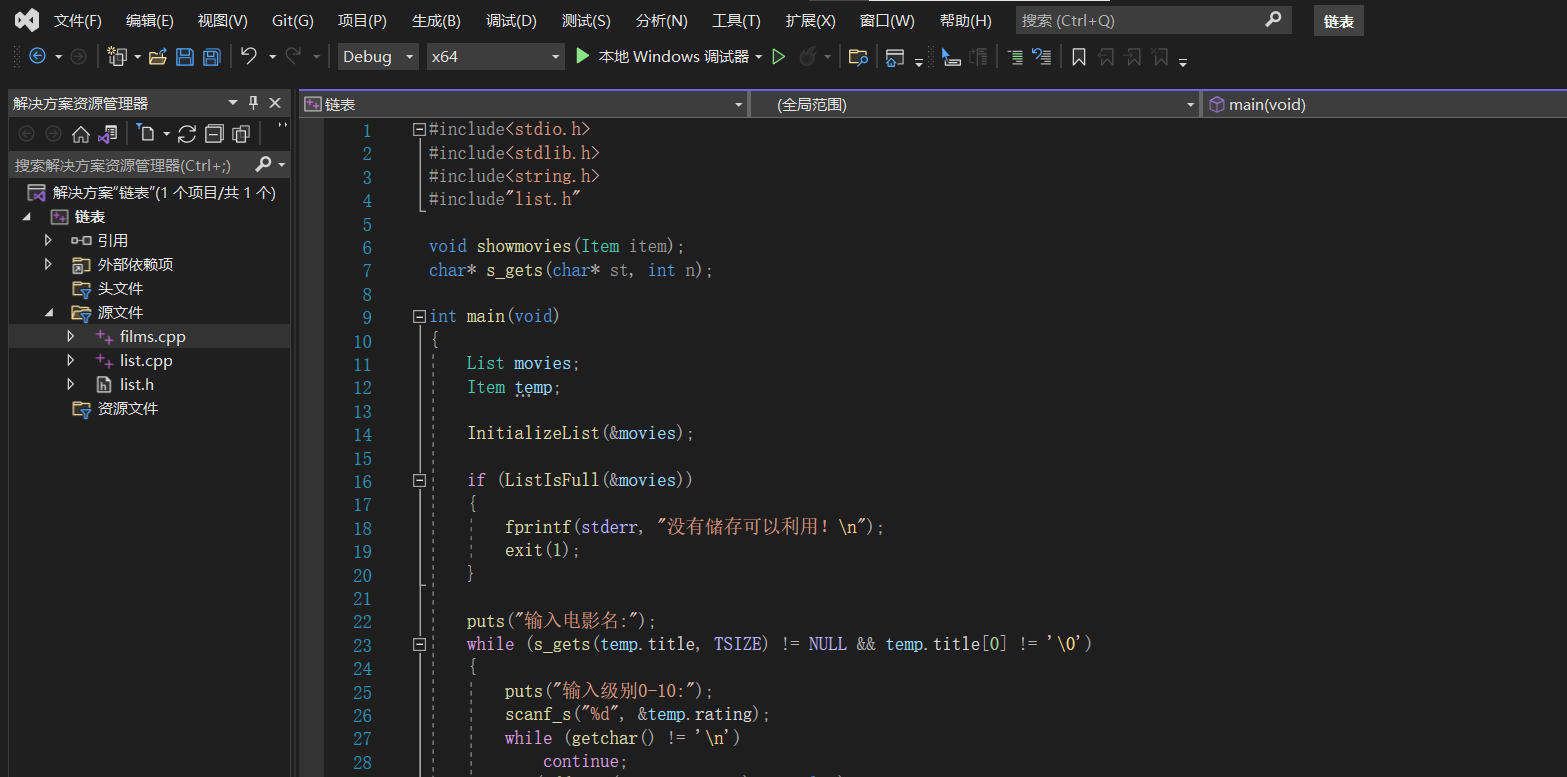
目录
一、链表的步骤
1.定义结构体
注意Node的定义中的next。
struct film
{
char title[TSIZE];
int rating;
};
typedef struct film Item;
typedef struct node
{
Item item;
struct node* next;
}Node;
typedef struct
{
Node* list;
}List; //定义List是为了让地址可以顺利传入,以便初始化2.链表初始化
void InitializeList(List* plist)
{
plist->list = NULL;
}
3.确定链表是否为空
/*确定链表是否为空 */
bool ListIsEmpty(const List* plist)
{
if (plist == NULL)
return true;
else
return false;
}4.确定链表是否为满
/*确定链表是否为满 */
bool ListIsFull(const List* plist)
{
Node* pt;
bool full;
pt = (Node*)malloc(sizeof(Node));
if (pt == NULL)
full = true;
else
full = false;
free(pt);
return full;
}5.确定链表项数
/*确定链表项数 */
unsigned int ListItemCount(const List* plist)
{
unsigned int count = 0;
Node* pnode = plist->list;
while (pnode != NULL)
{
++count;
pnode = pnode->next;
}
return count;
}6.链表末尾添加项
/*链表末尾添加项 */
bool AddItem(Item item, List* plist)
{
Node* pnew;
Node* scan = plist->list;
pnew = (Node*)malloc(sizeof(Node));
if (pnew == NULL)
return false;
CopyToNode(item, pnew);
pnew->next = NULL;
if (scan == NULL)
plist->list = pnew;
else
{
while (scan->next != NULL)
scan = scan->next;
scan->next = pnew;
}
return true;
}
/*将数据拷贝*/
void CopyToNode(Item item, Node* pnode)
{
pnode->item = item;
}7.遍历链表,把函数作用于每一项
/*遍历链表,把函数作用于每一项*/
void Traverse(const List* plist, void(*pfun)(Item item))
{
Node* pnode = plist->list;
while (pnode != NULL)
{
(*pfun)(pnode->item);
pnode = pnode->next;
}
}
/*传进来的函数*/
void showmovies(Item item)
{
printf("名字:%s 级别:%d\n", item.title, item.rating);
}
8.释放所有已分配内存
/*释放已分配内存 */
void EmptyTheLlist(List* plist)
{
Node* psave;
while (plist->list = NULL)
{
psave = plist->list->next;
free(plist->list);
plist->list = psave;
}
}二、完整代码
该程序缺少在中间插入和删除。
List.h 函数接口
#ifndef LIST_H_
#define LIST_H_
#include <stdbool.h>
#define TSIZE 45 //储存电影数目
struct film
{
char title[TSIZE];
int rating;
};
typedef struct film Item;
typedef struct node
{
Item item;
struct node* next;
}Node;
typedef struct
{
Node* list;
}List;
/*初始化链表 */
void InitializeList(List* plist);
/*确定链表是否为空 */
bool ListIsEmpty(const List* plist);
/*确定链表是否为满 */
bool ListIsFull(const List* plist);
/*确定链表项数 */
unsigned int ListItemCount(const List* plist);
/*链表末尾添加项 */
bool AddItem(Item item, List *plist);
/*遍历链表,把函数作用于每一项*/
void Traverse(const List* plist, void (*pfun)(Item item));
/*释放已分配内存 */
void EmptyTheLlist(List* plist);
#endif
List.cpp 函数实现
#include<stdio.h>
#include<stdlib.h>
#include "list.h"
/*拷贝节点*/
static void CopyToNode(Item item, Node* pnode);
/*初始化链表 */
void InitializeList(List* plist)
{
plist->list = NULL;
}
/*确定链表是否为空 */
bool ListIsEmpty(const List* plist)
{
if (plist == NULL)
return true;
else
return false;
}
/*确定链表是否为满 */
bool ListIsFull(const List* plist)
{
Node* pt;
bool full;
pt = (Node*)malloc(sizeof(Node));
if (pt == NULL)
full = true;
else
full = false;
free(pt);
return full;
}
/*确定链表项数 */
unsigned int ListItemCount(const List* plist)
{
unsigned int count = 0;
Node* pnode = plist->list;
while (pnode != NULL)
{
++count;
pnode = pnode->next;
}
return count;
}
/*链表末尾添加项 */
bool AddItem(Item item, List* plist)
{
Node* pnew;
Node* scan = plist->list;
pnew = (Node*)malloc(sizeof(Node));
if (pnew == NULL)
return false;
CopyToNode(item, pnew);
pnew->next = NULL;
if (scan == NULL)
plist->list = pnew;
else
{
while (scan->next != NULL)
scan = scan->next;
scan->next = pnew;
}
return true;
}
/*遍历链表,把函数作用于每一项*/
void Traverse(const List* plist, void(*pfun)(Item item))
{
Node* pnode = plist->list;
while (pnode != NULL)
{
(*pfun)(pnode->item);
pnode = pnode->next;
}
}
/*释放已分配内存 */
void EmptyTheLlist(List* plist)
{
Node* psave;
while (plist->list = NULL)
{
psave = plist->list->next;
free(plist->list);
plist->list = psave;
}
}
void CopyToNode(Item item, Node* pnode)
{
pnode->item = item;
}
films.cpp 链表应用
#include<stdio.h>
#include<stdlib.h>
#include<string.h>
#include"list.h"
void showmovies(Item item);
char* s_gets(char* st, int n);
int main(void)
{
List movies;
Item temp;
InitializeList(&movies);
if (ListIsFull(&movies))
{
fprintf(stderr, "没有储存可以利用!\n");
exit(1);
}
puts("输入电影名:");
while (s_gets(temp.title, TSIZE) != NULL && temp.title[0] != '\0')
{
puts("输入级别0-10:");
scanf_s("%d", &temp.rating);
while (getchar() != '\n')
continue;
if (AddItem(temp, &movies) == false)
{
fprintf(stderr, "内存分配问题!\n");
break;
}
if (ListIsFull(&movies))
{
puts("链表已满!");
break;
}
puts("输入下一个电影的名字(回车则停止):");
}
if (ListIsEmpty(&movies))
{
printf("无数据!\n");
}
else
{
printf("电影列表:\n");
Traverse(&movies, showmovies);
}
printf("有 %d 部电影\n", ListItemCount(&movies));
EmptyTheLlist(&movies);
printf("退出成功!/n");
return 0;
}
void showmovies(Item item)
{
printf("名字:%s 级别:%d\n", item.title, item.rating);
}
char* s_gets(char* st, int n)
{
char* ret_val;
char* find;
ret_val = fgets(st, n, stdin);
if (ret_val)
{
find = strchr(st, '\n');
if (find)
*find = '\0';
else
while (getchar() != '\n')
continue;
}
return ret_val;
}
三、运行结果


Lies never hurt anyone, the truth is the sharp knife!
谎言不会伤人,真相才是快刀!





















 2万+
2万+











 被折叠的 条评论
为什么被折叠?
被折叠的 条评论
为什么被折叠?








